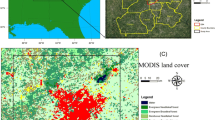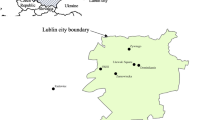Abstract
Urban heat islands (UHIs) are the phenomenon of urban regions usually being warmer than rural regions, which significantly impacts both the regional ecosystem and societal activities. Numerical simulation can provide spatially and temporally continuous datasets for UHI analysis. In this study, a spatially and temporally continuous ground temperature dataset of Xi’an, China was obtained through numerical simulation based on the Community Land Model version 4.5 (CLM4.5), at a temporal resolution of 30 min and a spatial resolution of 0.05∘× 0.05∘. Based on the ground temperature, the seasonal average UHI intensity (UHII) was calculated and the seasonal variation of the UHI effect was analyzed. The monthly variation tendency of the urban heat stress was also investigated. Based on the diurnal cycle of ground temperature and the UHI effect in each season, the variation tendencies of the maximum, minimum, and average UHII were analyzed. The results show that the urban heat stress in summer is the strongest among all four seasons. The heat stress in urban areas is very significant in July, and the UHII is the weakest in January. Regarding the diurnal cycle of UHII, the maximum always appears at 06:30 UTC to 07:30 UTC, while the minimum intensity of the UHI effect occurs at different times in the different seasons. The results of this study could provide a reference for policymakers about how to reduce the damage caused by heat stress.











Similar content being viewed by others
References
Aikawa, M., Hiraki, T., Eiho, J., & Miyazaki, H. (2007). Characteristic air temperature distributions observed in summer and winter in urban area in Japan. Environmental Monitoring and Assessment, 131 (1), 255–265.
Anderson, M., Norman, J., Kustas, W., Li, F., Prueger, J., & Mecikalski, J. (2005). Effects of vegetation clumping on two–source model estimates of surface energy fluxes from an agricultural landscape during smacex. Journal of Hydrometeorology, 6(6), 892–909.
Bowling, S. (1983). Meteorological factors responsible for high CO levels in Alaskan cities. Environmental Research Laboratory, Office of Research and Development, US Environmental Protection Agency.
Cao, C., Lee, X., Liu, S., Schultz, N., Xiao, W., Zhang, M., & Zhao, L. (2016). Urban heat islands in China enhanced by haze pollution. Nature Communications, 7, 12509.
Chen, X., Zhao, H., Li, P., & Yin, Z. (2006). Remote sensing image-based analysis of the relationship between urban heat island and land use/cover changes. Remote Sensing of Environment, 104 (2), 133–146.
Chen, Y., Yang, K., He, J., Qin, J., Shi, J., Du, J., & He, Q. (2011). Improving land surface temperature modeling for dry land of China. Journal of Geophysical Research: Atmospheres, 116(D20), 104.
Chow, W., & Roth, M. (2006). Temporal dynamics of the urban heat island of singapore. International Journal of Climatology, 26(15), 2243–2260.
Du, H., Wang, D., Wang, Y., Zhao, X., Qin, F., Jiang, H., & Cai, Y. (2016). Influences of land cover types, meteorological conditions, anthropogenic heat and urban area on surface urban heat island in the yangtze river delta urban agglomeration. Science of the Total Environment, 571, 461–470.
Gent, P., Danabasoglu, G., Donner, L., Holland, M., Hunke, E., Jayne, S., Lawrence, D., Neale, R., Rasch, P., Vertenstein, M., et al. (2011). The community climate system model version 4. Journal of Climate, 24 (19), 4973–4991.
Giannaros, T., Melas, D., Daglis, I., Keramitsoglou, I., & Kourtidis, K. (2013). Numerical study of the urban heat island over athens (greece) with the wrf model. Atmospheric Environment, 73, 103–111.
Haashemi, S., Weng, Q., Darvishi, A., & Alavipanah, S. (2016). Seasonal variations of the surface urban heat island in a semi-arid city. Remote Sensing, 8(4), 352.
Ho, H., Knudby, A., Xu, Y., Hodul, M., & Aminipouri, M. (2016). A comparison of urban heat islands mapped using skin temperature, air temperature, and apparent temperature (humidex), for the greater vancouver area. Science of the Total Environment, 544, 929–938.
Iodice, P., & Senatore, A. (2012). Analysis of a scooter emission behavior in cold and hot conditions: modelling and experimental investigations. SAE Technical Paper.
Iodice, P., & Senatore, A. (2013). Road transport emission inventory in a regional area by using experimental two-wheelers emission factors. In Lectures notes in engineering and computer sciences: proceedings of the world congress on engineering (pp. 681–685).
Iodice, P., & Senatore, A. (2015). Appraisal of pollutant emissions and air quality state in a critical italian region: Methods and results. Environmental Progress and Sustainable Energy, 34(5), 1497–1505.
Jackson, T., Feddema, J., Oleson, K., Bonan, G., & Bauer, J. (2010). Parameterization of urban characteristics for global climate modeling. Annals of the Association of American Geographers, 100 (4), 848–865.
Kustas, W., & Anderson, M. (2009). Advances in thermal infrared remote sensing for land surface modeling. Agricultural and Forest Meteorology, 149(12), 2071–2081.
Lawrence, D., Oleson, K., Flanner, M., Thornton, P., Swenson, S., Lawrence, P., Zeng, X., Yang, Z., Levis, S., Sakaguchi, K., et al. (2011). Parameterization improvements and functional and structural advances in version 4 of the community land model. Journal of Advances in Modeling Earth Systems, 3(1), M03001.
Li, H., Sun, D., Yu, Y., Wang, H., Liu, Y., Liu, Q., Du, Y., Wang, H., & Cao, B. (2014). Evaluation of the viirs and modis lst products in an arid area of Northwest China. Remote Sensing of Environment, 142, 111–121.
Magee, N., Curtis, J., & Wendler, G. (1999). The urban heat island effect at fairbanks, Alaska. Theoretical and Applied Climatology, 64(1), 39–47.
Meehl, G., & Tebaldi, C. (2004). More intense, more frequent, and longer lasting heat waves in the 21st century. Science, 305(5686), 994–997.
Miao, S., Chen, F., LeMone, M.A., Tewari, M., Li, Q., & Wang, Y. (2009). An observational and modeling study of characteristics of urban heat island and boundary layer structures in Beijing. Journal of Applied Meteorology and Climatology, 48(3), 484–501.
Ohashi, Y., Genchi, Y., Kondo, H., Kikegawa, Y., Yoshikado, H., & Hirano, Y. (2007). Influence of air-conditioning waste heat on air temperature in tokyo during summer: numerical experiments using an urban canopy model coupled with a building energy model. Journal of Applied Meteorology and climatology, 46(1), 66–81.
Oke, T. (1995). The heat island of the urban boundary layer: characteristics, causes and effects. In Wind climate in cities (pp. 81–107): Springer.
Oleson, K., Bonan, G., Feddema, J., Vertenstein, M., & Kluzek, E. (2010a). Technical description of an urban parameterization for the community land model (clmu). Boulder: NCAR.
Oleson, K., Lawrence, D., Gordon, B., Flanner, M., Kluzek, E., Peter, J., Levis, S., Swenson, S., Thornton, E., Feddema, J., et al. (2010b). Technical description of version 4.0 of the community land model (clm). Boulder: NCAR.
Oleson, K., Bonan, G., Feddema, J., & Jackson, T. (2011). An examination of urban heat island characteristics in a global climate model. International Journal of Climatology, 31(12), 1848–1865.
Oleson, K., Lawrence, D., Bonan, G., Drewniak, B., Huang, M., Koven, C., Levis, S., Li, F., Riley, W., Subin, Z., Swenson, S., & Thornton, P. (2013). Technical description of version 4.5 of the community land model (clm). Boulder: NCAR.
Oleson, K., Monaghan, A., Wilhelmi, O., Barlage, M., Brunsell, N., Feddema, J., Hu, L., & Steinhoff, D. (2015). Interactions between urbanization, heat stress, and climate change. Climatic Change, 129(3–4), 525–541.
Peng, S., Piao, S., Ciais, P., Friedlingstein, P., Ottle, C., Breon, F., Nan, H., Zhou, L., & Myneni, R. (2011). Surface urban heat island across 419 global big cities. Environmental Science & Technology, 46(2), 696–703.
Rizwan, A., Dennis, L., & Chunho, L. (2008). A review on the generation, determination and mitigation of urban heat island. Journal of Environmental Sciences, 20(1), 120–128.
Saaroni, H., Ben-Dor, E., Bitan, A., & Potchter, O. (2000). Spatial distribution and microscale characteristics of the urban heat island in tel-aviv, Israel. Landscape and Urban Planning, 48(1), 1–18.
Salamanca, F., Martilli, A., & Yagüe, C. (2012). A numerical study of the urban heat island over madrid during the desirex (2008) campaign with wrf and an evaluation of simple mitigation strategies. International Journal of Climatology, 32(15), 2372–2386.
Shen, H., Li, X., Cheng, Q., Zeng, C., Yang, G., Li, H., & Zhang, L. (2015). Missing information reconstruction of remote sensing data: a technical review. IEEE Geoscience and Remote Sensing Magazine, 3(3), 61–85.
Shen, H., Huang, L., Zhang, L., Wu, P., & Zeng, C. (2016a). Long-term and fine-scale satellite monitoring of the urban heat island effect by the fusion of multi-temporal and multi-sensor remote sensed data: a 26-year case study of the city of wuhan in china. Remote Sensing of Environment, 172, 109–125.
Shen, H., Meng, X., & Zhang, L. (2016b). An integrated framework for the spatio-temporal-spectral fusion of remote sensing images. IEEE Transactions on Geoscience and Remote Sensing, 54(12), 7135–7148.
Smith, D., Cusack, S., Colman, A., Folland, C., Harris, G., & Murphy, J. (2007). Improved surface temperature prediction for the coming decade from a global climate model. Science, 317(5839), 796–799.
Sun, D., & Pinker, R. (2003). Estimation of land surface temperature from a geostationary operational environmental satellite (goes-8). Journal of Geophysical Research: Atmospheres, 108(D11), 4326.
Tran, H., Uchihama, D., Ochi, S., & Yasuoka, Y. (2006). Assessment with satellite data of the urban heat island effects in asian mega cities. International Journal of Applied Earth Observation and Geoinformation, 8(1), 34–48.
Viovy, N. (2011). Cruncep dataset. http://dods.extra.cea.fr/data/p529viov/cruncep/readme.htm, http://dods.extra.cea.fr/store/p529viov/cruncep/V4_1901_2011/. Accessed: 10 August 2013.
Voogt, J., & Oke, T. (2003). Thermal remote sensing of urban climates. Remote sensing of environment, 86(3), 370–384.
Wan, Z. (2014). New refinements and validation of the collection-6 modis land-surface temperature/emissivity product. Remote Sensing of Environment, 140, 36–45.
Wan, Z., Zhang, Y., Zhang, Q., & Li, Z. (2004). Quality assessment and validation of the modis global land surface temperature. International Journal of Remote Sensing, 25(1), 261–274.
Weng, Q. (2009). Thermal infrared remote sensing for urban climate and environmental studies: methods, applications, and trends. ISPRS Journal of Photogrammetry and Remote Sensing, 64(4), 335–344.
Weng, Q., & Fu, P. (2014). Modeling diurnal land temperature cycles over los angeles using downscaled goes imagery. ISPRS Journal of Photogrammetry and Remote Sensing, 97, 78–88.
Xu, S. (2009). An approach to analyzing the intensity of the daytime surface urban heat island effect at a local scale. Environmental Monitoring and Assessment, 151(1), 289–300.
Yang, K., He, J., Tang, W., Qin, J., & Cheng, C.C. (2010). On downward shortwave and longwave radiations over high altitude regions: Observation and modeling in the tibetan plateau. Agricultural and Forest Meteorology, 150(1), 38–46.
Yu, W., Ma, M., Wang, X., Geng, L., Tan, J., & Shi, J. (2014). Evaluation of modis lst products using longwave radiation ground measurements in the northern arid region of China. Remote Sensing, 6(11), 11,494–11,517.
Yuan, F., & Bauer, M. (2007). Comparison of impervious surface area and normalized difference vegetation index as indicators of surface urban heat island effects in landsat imagery. Remote Sensing of Environment, 106(3), 375– 386.
Zakšek, K., & Oštir, K. (2012). Downscaling land surface temperature for urban heat island diurnal cycle analysis. Remote Sensing of Environment, 117, 114–124.
Zhang, H., Jin, M., & Leach, M. (2017). A study of the oklahoma city urban heat island effect using a wrf/single-layer urban canopy model, a joint urban 2003 field campaign, and modis satellite observations. Climate, 5(3), 72.
Zhang, K., Wang, R., Shen, C., & Da, L. (2010). Temporal and spatial characteristics of the urban heat island during rapid urbanization in Shanghai, China. Environmental Monitoring and Assessment, 169 (1), 101–112.
Zhao, L., Lee, X., Smith, R.B., & Oleson, K. (2014). Strong contributions of local background climate to urban heat islands. Nature, 511(7508), 216–219.
Acknowledgements
This work was supported by the National Natural Science Foundation of China (41422108, 41661134015); Cross-disciplinary Collaborative Teams Program for Science, Technology and Innovation of the Chinese Academy of Sciences.
Author information
Authors and Affiliations
Corresponding author
Rights and permissions
About this article
Cite this article
Gao, M., Shen, H., Han, X. et al. Multiple timescale analysis of the urban heat island effect based on the Community Land Model: a case study of the city of Xi’an, China. Environ Monit Assess 190, 8 (2018). https://doi.org/10.1007/s10661-017-6320-9
Received:
Accepted:
Published:
DOI: https://doi.org/10.1007/s10661-017-6320-9




